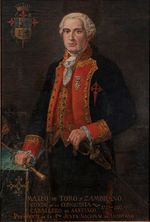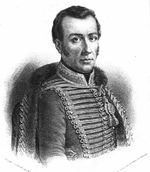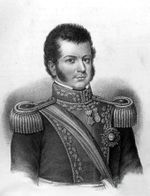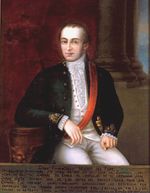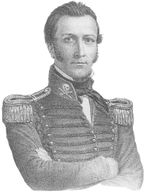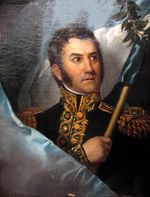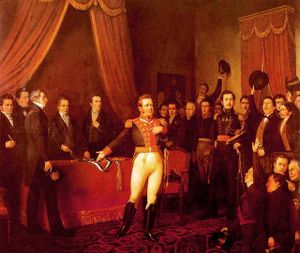حرب الاستقلال التشيلية
| حرب الاستقلال التشيلية | |||||||
|---|---|---|---|---|---|---|---|
| جزء من حروب استقلال أمريكا الاسبانية | |||||||
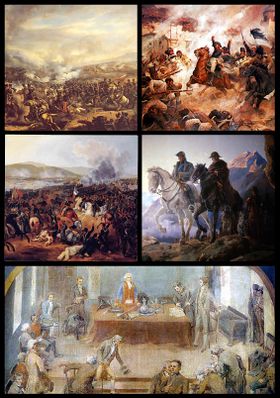 مع عقارب الساعة من أعلى اليسار: معركة إل روبلى، معركة رانكاگوا, Crossing of the Andes, First Government Junta, Battle of Maipú. | |||||||
| |||||||
| المتحاربون | |||||||
|
Mapuches المطالبين بالاستقلال | ماپوتشى مؤيدون للملكية | ||||||
| القادة والزعماء | |||||||
|
|
| ||||||
قالب:Campaignbox Chilean War of Independence
حرب الاستقلال التشيلية كانت حرباً بين شعوب الكريولو التشيلية المطالبة بالاستقلال السياسي والاقتصادي عن اسبانيا والكريول الملكيين الداعمين لاستمرار الولاء لقبطانية تشيلى العامة وللبقاء في الامبراطورية الاسبانية.
تقليدياً، تؤرَّخ بداية الحرب بيوم 18 سبتمبر 1810. Depending on what terms are used to define its end, it lasted until 1821, when royalist forces were defeated by José de San Martín; or until 1826, when the last Spanish troops surrendered and the Chiloé Archipelago was incorporated to the Chilean republic. A declaration of independence was officially issued by Chile on February 12, 1818 and formally recognized by Spain in 1844, when full diplomatic relations were established.[1]
The Chilean War of Independence was part of the more aroused Spanish American wars of independence. Independence did not have unanimous support among Chileans, who were divided between independentists and royalists. What started as a political movement among elites against the colonial power, ended as a full-fledged civil war. Traditionally, the process is divided into three stages: the Patria Vieja, 1810–1814; the Reconquista, 1814–1817; and the Patria Nueva, 1817–1823.
خلفية
At the start of 1808, the Captaincy General of Chile – one of the smallest and poorest colonies in the Spanish Empire – was under the administration of Luis Muñoz de Guzmán, an able, respected and well-liked Royal Governor. In May 1808 the overthrow of Charles IV and Ferdinand VII, their replacement by Joseph Bonaparte and the start of the Peninsular War plunged the empire into a state of agitation. In the meantime, Chile was facing its own internal political problems. Governor Guzmán had suddenly died in February of that year and the crown had not been able to appoint a new governor before the invasion. After a brief interim regency by Juan Rodríguez Ballesteros, and according to the succession law in place at the time, the position was laid claim to and assumed by the most senior military commander, who happened to be Brigadier Francisco García Carrasco.
پارتيا ڤييخا
| تاريخ تشيلى |
|---|
 |
الطغمة الأولى
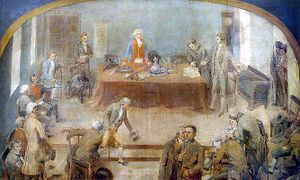
ديكتاتورية كاريرا
الغزوات الاسبانية
ريكونكويستا
پارتيا نوِڤا
الحرب حتى الموت
To further secure Chilean independence, San Martín launched a series of actions against armed bands in the mountains, consisting of assorted outlaws, royalists, and Indians who had taken advantage of the chaos of military expeditions and forced recruitments to pillage and sack the countryside. This time of irregular warfare was later called the Guerra a muerte (Total war) for its merciless tactics, as neither the guerillas nor the government soldiers took prisoners. Only after the band of Vicente Benavides was liquidated in 1822 was the region around Concepcion finally pacified.
إشهار ڤالديڤيا وتشيلوى
الوقع الاقتصادي
The independence wars in Chile (1810–1818) and Peru (1809–1824) had a negative impact on the Chilean wheat industry. Trade was disrupted and armies in Chile pillaged the countryside. The Guerra a muerte phase was particularly destructive and ended only to see a period of outlaw banditry (e.g. Pincheira brothers) occur until the late 1820s. Trade with Peru did not fully recover after the independence struggles.[2] Being isolated from Central Chile by hostile Mapuche-controlled territory and dependent upon seaborne trade with the port of Callao in Peru the city of Valdivia was particularly badly hit by the decline of the trade with Peru. The fortune of this city would not shift until the arrival of German settlers in the late 1840s.[3]
The Chilean ruling elite adopted a free trade policy already in 1811 with the "Decreto de Libre Comercio".[4] This allowed the country in the mid-19th century to exploit the opportunities that the California Gold Rush and the Australian gold rushes created for exporting wheat.[5][6]
انظر أيضاً
المراجع
- ^ "Chile". World Statesmen. Retrieved 31 March 2012.
- ^ (in إسپانية) Villalobos, Sergio; Silva, Osvaldo; Silva, Fernando and Estelle, Patricio. 1974. Historia De Chile. Editorial Universitaria, Chile. p 406-413.
- ^ Bernedo Pinto, Patricio (1999), "Los industriales alemanes de Valdivia, 1850-1914", Historia 32: 5–42, http://www.memoriachilena.cl/archivos2/pdfs/MC0001325.pdf
- ^ (in إسپانية) Historia contemporánea de Chile III. La economía: mercados empresarios y trabajadores. 2002. Gabriel Salazar and Julio Pinto. p. 19-20.
- ^ (in إسپانية) La Hacienda (1830–1930). Memoria Chilena.
- ^ (in إسپانية) Villalobos, Sergio; Silva, Osvaldo; Silva, Fernando and Estelle, Patricio. 1974. Historia De Chile. Editorial Universitaria, Chile. p 481-485.
للاستزادة
- Barros Arana, Diego (1850). Estudios históricos sobre Vicente Benavides i las campañas del Sur: 1818-1822 (in Spanish). Santiago, Chile: Imprenta de Julio Belin i Compañia.
{{cite book}}: CS1 maint: unrecognized language (link) - Barros Arana, Diego (1855). Historia Jeneral de la Independencia de Chile (in Spanish). Vol. I–IV. Santiago, Chile: Imprenta del Ferrocarril.
{{cite book}}: CS1 maint: unrecognized language (link) - Barros Arana, Diego (1884–1902). Historia Jeneral de Chile (in Spanish). Vol. I–XVI. Santiago, Chile: Rafael Jover.
{{cite book}}: CS1 maint: unrecognized language (link) - Castedo, Leopoldo (1954). Resumen de la Historia de Chile de Francisco Antonio Encina (in Spanish). Vol. 2. Santiago, Chile: Empresa Editora Zig-Zag.
{{cite book}}: CS1 maint: unrecognized language (link) - Encina, Francisco Antonio (1940–1952). Historia de Chile: desde la prehistoria hasta 1891 (in Spanish). Vol. I–XX. Santiago, Chile: Editorial Nascimento.
{{cite book}}: CS1 maint: unrecognized language (link) - Gay, Claudio (1856). Historia de la Independencia Chilena (in Spanish). Vol. I & II. Paris, France: Imprenta de E. Thunot y Cia.
{{cite book}}: CS1 maint: unrecognized language (link) - Harvey, Robert. "Liberators: Latin America`s Struggle For Independence, 1810-1830". John Murray, London (2000). ISBN 0-7195-5566-3
- Herring, Hubert (1968). A History of Latin America. New York, NY: Alfred A Knopf.
- Prago, Albert (1970). The Revolutions in Spanish America. New York, NY: The Macmillan Company.
- Vicuña Mackenna, Benjamín (1849). El sitio de Chillán (in Spanish). Santiago, Chile: Periodico La Tribuna.
{{cite book}}: CS1 maint: unrecognized language (link) - Vicuña Mackenna, Benjamín (1868). La guerra a muerte: memoria sobre las últimas campañas de la Independencia de Chile (1819–1824) (in Spanish). Santiago, Chile: Imprenta Nacional. p. 562.
{{cite book}}: CS1 maint: unrecognized language (link)
- Articles with إسپانية-language sources (es)
- Articles with hatnote templates targeting a nonexistent page
- Missing redirects
- Portal templates with default image
- حرب الاستقلال التشيلية
- حروب استقلال أمريكا الاسبانية
- حروب تشيلى
- حروب اسبانيا
- عقد 1810 في قبطانية تشيلى العامة
- عقد 1820 في تشيلى
- 1810 في قبطانية تشيلى العامة
- 1821 في تشيلى
- 1826 في تشيلى
- 1810 في الامبراطورية الاسبانية
- 1821 في الامبراطورية الاسبانية
- 1826 في الامبراطورية الاسبانية
- 1810s في الامبراطورية الاسبانية
- عقد 1820 في الامبراطورية الاسبانية
